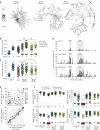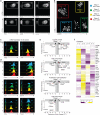Class-switched memory B cells remodel BCRs within secondary germinal centers
- PMID: 25642821
- PMCID: PMC4333102
- DOI: 10.1038/ni.3095
Class-switched memory B cells remodel BCRs within secondary germinal centers
Abstract
Effective vaccines induce high-affinity memory B cells and durable antibody responses through accelerated mechanisms of natural selection. Secondary changes in antibody repertoires after vaccine boosts suggest progressive rediversification of B cell receptors (BCRs), but the underlying mechanisms remain unresolved. Here, the integrated specificity and function of individual memory B cell progeny revealed ongoing evolution of polyclonal antibody specificities through germinal center (GC)-specific transcriptional activity. At the clonal and subclonal levels, single-cell expression of the genes encoding the costimulatory molecule CD83 and the DNA polymerase Polη segregated the secondary GC transcriptional program into four stages that regulated divergent mechanisms of memory BCR evolution. Our studies demonstrate that vaccine boosts reactivate a cyclic program of GC function in class-switched memory B cells to remodel existing antibody specificities and enhance durable immunological protection.
Figures







Comment in
-
B cell memory: A second chance for antibodies.Nat Rev Immunol. 2015 Mar;15(3):131. doi: 10.1038/nri3829. Epub 2015 Feb 20. Nat Rev Immunol. 2015. PMID: 25698675 No abstract available.
References
Publication types
MeSH terms
Substances
Grants and funding
LinkOut - more resources
Full Text Sources
Other Literature Sources
Molecular Biology Databases
Research Materials
Miscellaneous

